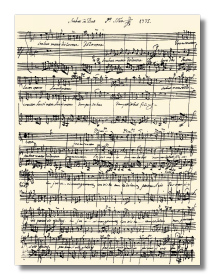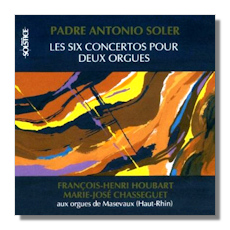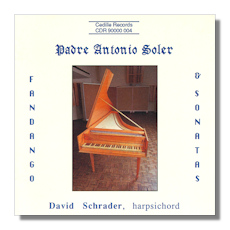
The Internet's Premier Classical Music Source
Related Links
-
Find CDs & Downloads
Amazon - UK - Germany - Canada - France - Japan
ArkivMusic - CD Universe
Find DVDs & Blu-ray
Amazon - UK - Germany - Canada - France - Japan
ArkivMusic-Video Universe
Find Scores & Sheet Music
Sheet Music Plus -
- Harpsichord Music of Antonio Soler by Ray Izumi
Recommended Links
Site News
Padre Antonio Soler

(1729 - 1783)
Antonio Francisco Javier José Soler Ramos was born to Marcus Mateo Pedro Soler and Maria Teresa Ramos in 1729 in Olot, Catalonia. The actual date of his birth is unrecorded, but we can deduce mid to late November as an approximate time. Baptismal records testify that he was christened in the church of Sant Esteve on December 3rd of that year. We can also speculate that the Soler household was a musical one; his father served as a musician in the Numancian regiment and entered Antonio into the Escolonia of the Monastery at Montserrat when he was six. Entry into the famous choir school was decided by audition, so he either possessed a fine voice, or received excellent musical tuition from his father; possibly a combination of both. Soler remained there for about ten or eleven years in the twelfth-century institution that was reputedly one of the finest musical establishments in the world. His teachers at the Escolonia were Benito Esteve, and Benito Valls who was organist. Antonio's progress was rapid and at the age of fourteen he applied for the post as chapel master at two cathedrals and was appointed organist of the Cathedral at Seo de Urgell. At this same time he was also made a sub-deacon, and at the age of twenty-three took Holy Orders, entering the Escorial as a Hieronymite monk in the Order of Saint Jerome, where he remained in relative confinement for the rest of his life. This monastic solitude is well documented by a colleague who wrote an extremely comprehensive obituary notice, describing a man who loved his cell and was always there except for duty. However, this was probably not the whole story as in an obituary notice to a friend, the wind player, Pedro Serra, Soler revealed that travelling musicians and dancers from Spain and abroad were frequent visitors to the Escorial; an aspect he would clearly have witnessed. Entertainment at the Escorial is scantily documented, but we know that there were court functions and on festival days in particular, the streets in Madrid thronged with people, processing, dancing, and playing guitars and castanets with monks also participating in the festivities. San Isidro (a 12th century Saint) whose feast day is celebrated annually on May 15th in the Carabanchel suburb of Madrid, is a prime example of how festivals from that period are celebrated to this day.
This contact with secular activities may then hold the key to Soler's more powerful sonatas inspired by the fiery flamenco spirit that ignites much of his music. As a native of Catalonia, Soler would have been familiar with Catalan taste for the round dance from which the sardana evolved: a dance, usually in 6/8 time alternating with 3/4 and it is syncopation of this nature that infuses the dance with life. The round dance in earlier forms was performed by medieval pilgrims to the Montserrat monastery, a tradition that survives to this day. This affinity with the folk music and dance of his native land clearly manifests itself in the cross rhythms and vocal melismas that infuse his sonatas. Fingerprints of the 'galant' style are also evident in his harpsichord music with melodic ingenuity, grace and beauty that are so characteristic of that period. In 1762, Soler's Llave de la modulación was published; a highly controversial harmony treatise that drew criticism from many quarters. He was also credited with inventing a tuning device which he called afinador with plucked strings that divided the octave into microtones. From around 1765, Soler was appointed music master to the Infante don Gabriel, favourite son of Carlos III for whom he wrote around 200 harpsichord sonatas. The Infante's proficiency must have been outstanding as many of the sonatas are virtuoso works.
Many have speculated on whether Soler actually studied with Scarlatti. The two would certainly have met and indeed the Fitzwilliam museum in Cambridge owns a copy of Soler's sonatas, printed in London. The copy belonging to Lord Fitzwilliam is signed and dated 1796 and inscribed by him as follows: "The originals of these harpsichord lessons were given to me by Father Soler at the Escorial, the 14th of February, 1772. Father Soler had been instructed by Scarlatti."
Soler rightly claims a prominent position amongst those composers who became beacons of the Classical enlightenment and whose music possessed elements of genius. The obituary notice of this devout and humble soul on December 20th 1783 stated that, "Our Lord, who has decreed every moment of our lives, recalled him at half past five in the morning."
His other works include 6 quintets for string quartet, organ, 6 concertos for two organs, around 130 choral works with Latin texts and many villancicos, devotional works sung during matins on the feasts during the Catholic calendar. ~Richard Lester
Recommended Recordings
Concertos for 2 Organs
- 6 Concertos/Solstice SOCD076
-
François-Henri Houbart & Marie-José Chasseguet (organs)
- 6 Concertos/Titanic Ti-152
-
Bernard Brauchli & Estéban Elizondo (organs)
- 6 Concertos/Brilliant 93763
-
Maurizio Croci & Pieter Van Dijk (organs)
Fandango
- Fandango in D minor, SR 146 & Sonatas/Philips 432830-2
-
Rafael Puyana (harpsichord)
- Fandango in D minor, SR 146 & Sonatas/Erato 2292-45435-2
-
Scott Ross (harpsichord)
- Fandango in D minor, SR 146 & Sonatas/Cedille CDR90000004
-
David Schrader (harpsichord)
 Sonatas for Harpsichord
Sonatas for Harpsichord
- 9 Sonatas, SR 12, 15, 49, 54, 56, 69, 76, 84, 90 & Fandango/Erato 2292-45435-2
-
Scott Ross (harpsichord)
- 11 Sonatas, SR 19, 41, 72, 78, 84-88, 90 & Fandango/Virgin Classics Veritas VC791172-2
-
Maggie Cole (harpsichord & fortepiano)
Amazon - UK - Germany - Canada - France - Japan - ArkivMusic - CD Universe
Or Reissued on Virgin VER561220-2
Amazon - UK - Germany - Canada - France - Japan - ArkivMusic - 7 Sonatas, SR 4, 9, 16, 24, 25, 60, 63 & Fandango/Cedille CDR90000004
-
David Schrader (harpsichord)
- 6 Sonatas, SR 19, 21, 84, 88, 90, 117, Concerto & Fandango/Philips 432830-2
-
Rafael Puyana (harpsichord)
- 11 Sonatas, SR 35, 38, 70, 71, 77-79, 82, 83, 113, 166 & Prelude #8/Astrée E8776
-
Robert van Asperen (harpsichord)
- 7 Sonatas, SR 15, 45, 56, 84, 88, 90 & 117 w/ Seixas/Nimbus NI5836
-
Richard Lester (harpsichord)















